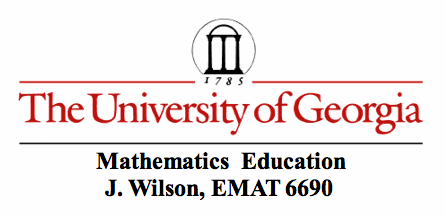

Definition:
Given a right triangle,, when c is the length of the hypotenuse and a, b are the lengths of the legs.
The Pythagorean theorem is commonly depicted using the following representation.
In this representation, we can see that the area of the green square, a^2, and the area of the yellow square, b^2, sum to the area of the red square, c^2.
The following questions have students construct and provide a proof for this representation.
Given a square window with four square panes and a square inset of colored glass whose vertices are at the midpoints of the sides of the window, if a is the length of the side of one of the panes and if c is the length of the side of the square inset of colored glass, find the relation between a and c.
Given a square window, make a square inset where the vertices of the inset are on the sides of the window. When making the panes, use two of the vertices of the insert. Justify that the quadrilateral that you made in indeed a square. Then make four rectangular panes. Two of these panes should be squares. If a and b are the lengths of the sides of the two squares, and if c is the length of the side of the inset, Find a relation among the area of these three squares. That is, prove the Pythagorean theorem.
This is by no means the only way to prove the Pythagorean theorem.
In the book, The Pythagorean Proposition, Loomis discusses 357 different proofs.Lets look at another proof.
Garfield’s Proof:
James Garfield discovered this proof in 1876. He later became the twentieth president of the United States.
In this proof, we will use our knowledge of the area of a trapezoid to derive the Pythagorean theorem.
Start by constructing a right triangle. Label the legs (a and b) and the hypotenuse (c).
Next, construct a congruent triangle and position it like in the picture below.
In GSP, this can be achieved by rotating the right triangle 90° and translating it (b’ + a) units to the right.
Use the tips of these two triangles to construct a segment and form a trapaziod.
We know that the Area of a Trapezoid= ½(b1 + b2)h, where b1 and b2 are the lengths of the bases and h is the length of the height.
In this trapezoid, b1 = b, b2 = a, and h = (a + b).
Observe,
Note that the area of the trapezoid can also be calculated by summing the area of the three right triangles contained within the trapezoid.
Setting these two areas equal to each other,
Next, we are going to look at a proof involving shears.
Shear Pythagoras:
Recall: A shear is a transformation of a rectangle into a parallelogram, which preserves one base and the corresponding height. Shears can be used in proving Pythagoras' Theorem because shears preserve area.
Like in our first exploration, we are showing that that the areas of the squares that extend off of the legs of a right triangle, a^2 and b^2, sum to c^2.
Observe,
Begin by constructing a line through point C, perpendicular to side c. Let D and E be the points where this perpendicular line intersects the red square.
Next, we want to drag the corners of the green and yellow so that they lie on the perpendicular line. This action transforms these two squares into parallelograms. These transformations, or shears, preserve the two areas as well.
Lastly, we drag the red square at point E so that it lies on point C. The square is transformed into a parallelogram and area is preserved.
We can now more easily see that the area of a^2 + b^2 = c^2, since we are left with two congruent parallelograms.
Pythagorean Theorem Puzzles:
There are many different Pythagorean Theorem Puzzles available. We are going to discuss three puzzles of varying difficulties.
Puzzle 1:
I would consider this type of puzzle to be the most simple. Below, I have included two examples.
Students are instructed to cut out the pieces of the puzzle and then determine how many of these pieces fit into the remaining square. Students will find that all of the pieces from the two smaller squares fit into the larger square. This shows students that the areas of the two smaller squares, a^2 and b^2, sum to get the area of the larger square, c^2.
This puzzle was obtained from: http://math.buffalostate.edu/~it/projects/Parker.pdf
Puzzle 2:
This puzzle is similar to Puzzle 1, when it comes to fitting pieces together. However, this puzzle is a little more complex and has an algebraic proof aspect.
We are given four congruent triangles and asked to fit them together to form a square with a side length of c.
Lets calculate the area of the square, c^2 in terms of a and b.
c^2 is equal to the area of the 4 triangles plus the area of the smaller square in the center.
The triangles each have an area of ½(a)(b) and the smaller square has an area of (b - a)^2.
Observe,
c^2 = 2ab + (b – a)^2
= 2ab + b^2 -2ab + a^2
= a2 + b2
Hence, c^2 = a^2 + b^2 as desired.
Puzzle 3:
In this puzzle, we use the same four congruent triangles from puzzle 2.Instead of fitting these triangles together to form a square with a side length of c, we are going to fit them together to form a square with a side length of (a + b).
Observe,
(a + b)^2 = 4(½ (ab)) + c^2,
a^2 + 2ab + b^2 = 2ab + c^2,
a^2 + b^2 = c^2Puzzles 2 and 3 were obtained from: http://www.cut-the-knot.org/pythagoras/index.shtml
Last, but not least, lets look at Euclid’s Proof of the Pythagorean Theorem.
Click here to return to Lacy's homepage